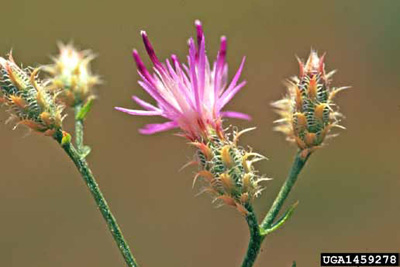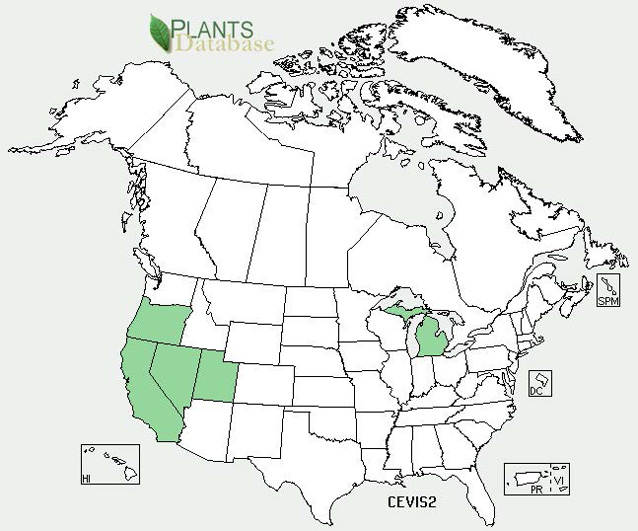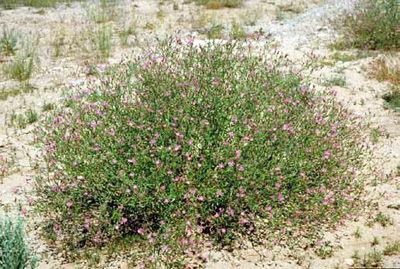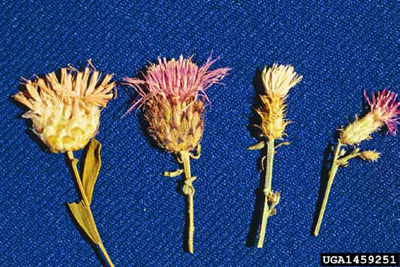Asteraceae (Sunflower family)
At a Glance

© Steve Dewey / Utah State University
- Perennial
- Highly branched stems that grow one to three feet tall
- Lower leaves are deeply dissected, but the upper leaves are entire and linear
- Flowers are pink to pale-purple
- Flowerheads have four to eight florets and appear more slender than the flowerheads of other knapweeds
- The bracts underneath the flower have a central spine that curves backwards
- Fruit is a golden to dark-brown achene
Habitat and Ecology
Squarrose knapweed (Centaurea virgata ssp. squarrosa) is present in Utah, Nevada, California, Oregon, Wisconsin, and Michigan. How it was introduced to North America is unknown. Squarrose knapweed often grows on degraded rangeland soils and tolerates drought and cold better than spotted (Centaurea maculosa) or diffuse knapweed (Centaurea diffusa). Squarrose knapweed is not palatable to livestock and can form monocultures. Its taxonomic status is uncertain: it is also known as Centaurea squarrosa and Centaurea virgata.

USDA
Description

© Steve Dewey / Utah State University
Squarrose knapweed is a long-lived perennial with highly branched stems that grow one to three feet tall. The stems grow above a woody crown and stout taproot. Under unfavorable conditions, the plants remain as basal rosettes before developing flowering stems. Squarrose knapweed reproduces by seed. The seed head falls near the parent plant, but the backwards-curved spines under the seed head can cling to hair, wool, fur, and clothing, allowing the seeds to disperse over greater distances.
Leaves
The leaves are alternate and simple. The lower leaves are deeply dissected into narrow segments, and the upper leaves have smooth, unbroken edges and are smaller and linear, appearing like bracts. The upper leaves do not have stems.
Flowers and Fruits
The flowerheads are pink to pale purple, and they appear more slender than the flowerheads of other species of knapweeds. Each head has four to eight, occasionally 10, florets. The bracts underneath the flowerhead are pale green to straw-colored, and the central spine of each bract usually curves backwards. Squarrose knapweed flowers June through August.
The fruit is an achene (a dry fruit with a single seed and thin walls that does not open at maturity; for example, a sunflower “seed”). Squarrose knapweed achenes are golden to dark brown with faint linear stripes, and they are usually capped with bristles. The achene and the bristles together are 3/16 to 1/4 inches long. Each head usually has one to four achenes. The heads start to fall in the late summer and fall, but they can remain on the plant until the following spring.
Etymology
Centaur’ea/Centaur’ium is a reference to the Centaur Chiron who supposedly discovered the medicinal uses of a plant in Greece that came to be called Centaury. Squarro’sa means either “scaly or rough” or “with the leaves spreading at right angles”.
Similar Species

Squarrose knapweed can be confused with other knapweed species, especially diffuse knapweed. Squarrose knapweed can be distinguished from diffuse knapweed by the bracts underneath the flower: the bracts of squarrose knapweed do not have teeth on the sides and their central spines bend backward.
Control Methods
Possible control methods are explained at these websites:
References
California Department of Food and Agriculture. No date. Centaurea in Encyloweedia. Available at https://www.cdfa.ca.gov/plant/ipc/encycloweedia/weedinfo/centaurea.htm.
Charters, M. L. 2009. California plant names: Latin and Greek meanings and derivations. Available at http://www.calflora.net/botanicalnames.
Colorado Department of Agriculture. 2009. Squarrose knapweed: identification and management. Colorado Department of Agriculture, Conservation Services Division, Lakewood, CO.
Roché, C., and L. C. Burrill. 1994. Squarrose knapweed. Pacific Northwest Extension Service publication PNW 422-E. Oregon State University, Corvallis, OR.
Prepared by Kelly Reeves, Southern Colorado Plateau Network Inventory and Monitoring Program, 2010.
Last updated: April 29, 2016
